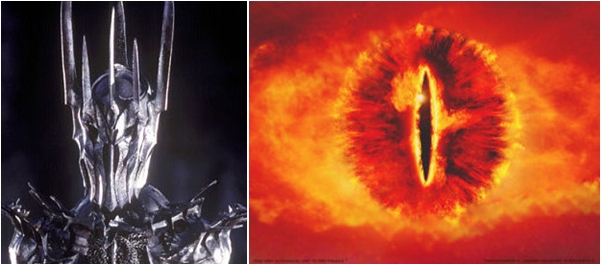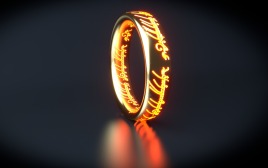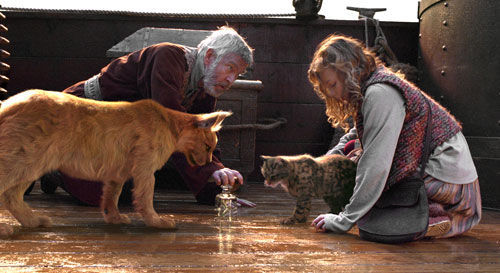Using digital techniques and all the paraphernalia of modern film-making, Jackson has really succeeded in his dream of bringing Tolkien's fairytale world to life. If we compare this with the cartoon film attempts of The Hobbit (1977) and LOTR(1978, partial), you'll know that Peter Jackson's version represents an improvement in almost every respect—though of course, what is possible now wasn't so then.
Jackson has not just taken Tolkien's work as it stands, but has also interpreted it—especially in The Hobbit trilogy. (Otherwise, The Hobbit would have been a single movie.) Both Jackson and Tolkien stand as modern mythmakers who would best be approached via mythologist Joseph Campbell and psychologist C. G. Jung. In addition, I would here like to investigate what their work signifies in terms of Sufism. Tolkien was a Christian thinker, but every great tale has universal import, and Tolkien's doctrinal side doesn't show, except perhaps ethically, which is not a problem but an advantage.
Before we go on, I should perhaps point out that Tolkien's religious standpoint lends him a predilection to magnify evil beyond its true proportions. Like Zoroastrianism, Christianity accords evil an inordinate amount of power: it is thought to be almost the equal of good, and Satan deemed capable even of killing God (in the hypostasis of the Son)—though not permanently. In Sufism, on the other hand, the devil is nowhere near so powerful. He is called "the Whisperer" of delusions (vesvâs), and if people do not heed his whisperings, he has no further power over them.
The result is that in Tolkien's work, all the bad guys are not simply villains, but supervillains, enemies who are well-nigh invincible. While this may not be an accurate portrayal of the powers of evil, it certainly adds dramatic effect, both in the storyline and the movies, and our heroes succeed against incredible odds.
The Levels of Selfhood
In terms of Sufism, then, the key to unlocking the codes of Tolkien's vast saga is the Sufic concept of the Base Self (nafs al-ammara). In Sufism, human beings are originally born good as gold and pure as starlight. They are not tainted with some indelible stain. As they grow up, however, the vagaries of this world take their toll, and the human self loses its original purity, slowly sinking into the mire of murky waters. It is like diving to the bottom of a sea. Having taken that dive, however, Sufism teaches that human beings can swim up and rise to the surface again. If gold falls into the mud, it doesn't lose its value: wash it off and it is gold again. The self can be purified, and the stage of the Base Self can be left behind in a succession of levels, until the self reaches its original purity (the "Purified Self"). Then it is as if one is reborn, and perceives the world as on Day One. Then, the answer to the Zen Koan: "What was your face before you were born?" is revealed. (The Sufi poet Harabi answers the riddle: "We were Real with the Real in the eternal past." This is but a different expression of the Koranic Verse: "We come from God and we shall return to Him" (2:156).)
When we look at Tolkien's epic in this way, we find that it abounds with portrayals of the Base Self. The whole of Middle Earth is crawling with all kinds of Base-Self types, such as orcs, trolls, balrogs, ghouls, wraiths, monsters, spiders, you name it. But of course, there are basically three of what you might call Base-Self "archetypes": Sauron, Gollum, and Smaug the dragon. So let us analyze the principal actors under several headings.
Gollum

Gollum. Would you buy a used car from this fellow?
Each of Tolkien's bad-guy characters reveals a different swatch of the Base Self's blameworthy ethics. Sly and deceitful, covetous and mendacious, Gollum draws a portrait that is both pitiful and revolting. His misdeeds and lies have resulted in a split personality. Yet in the immense machinations of the universe, even such a miserable character has a part to play. "God does not create a mote in vain." If not for him, the Ring of Power would never get cast into the fires of Mount Doom. In a sense, Gollum sacrifices himself together with the Ring. And perhaps therein lies his final, possible redemption.Sauron

Sauron and his All-seeing Eye.
Tolkien took Lord Acton's dictum to heart: "Power corrupts and absolute power corrupts absolutely." So did the Founding Fathers of America: if men were angels, they reasoned, there would be no need for laws to govern society, and if angels governed, there would be no need for checks on government. Neither of the former being the case, both of the latter were necessary.Sauron, also known as the Necromancer, represents the pinnacle of Lord Acton's vision, the diametrical opposite of what Tolkien and the Founding Fathers viewed as desirable. With his All-seeing Eye as a Panopticon, the Dark Lord keeps all under constant observation. To him, it does not matter that they are friend or foe. He watches them all, because he can.
"Sauron" can mean not just a person but a mentality, a state of mind. Suppose you're eavesdropping on a conversation behind closed doors. The Master said: "That's God's door—you have no right to listen." This is to sow corruption in God's good earth, and hence is immoral.
A democratic stance against totalitarianism is inherent in Tolkien's tale.
In George Orwell's dystopian novel 1984, Winston Smith is reading a book. The book explains how and why the world is ordered in the way it is. Then it says:
Here we reach the central secret. ... But deeper than this lies the original motive, the never-questioned instinct that first led to the seizure of power ... This motive really consists . . .
Winston never gets to read the rest of the sentence, and we are left to wonder what that motive really is. It seems as if Orwell is about to reveal an almost metaphysical level of explanation, but then he breaks off and never returns to it. I, too, wondered about it for years.Then I found the answer.
I found the answer in a book by the famous Sufi saint, Ahmed Sirhindi (also known as Imam Rabbani), and he was talking about the Base Self:
The self (nafs) in its state of impulsiveness (ammara) always strives to be superior. . . . It refuses to acknowledge its dependence on and debt to others. This is nothing but a claim to divinity. . . . Indeed, [such a] self will not settle even for partnership with God, but desires to subjugate even Him, to enslave all that exists. It is for this reason that aiding and abetting this self, the enemy of God, . . . is the greatest of follies and disasters.
(Mektubat ("Letters"), 52nd Letter, quoted in Bayman, Station, pp. 56-7.)
And that is why, in Tolkien's universe, Sauron is the Antichrist.(Once we know this, we also know that Tolkien is mythifying Armageddon for us in his wars.)
Bilbo and Frodo

Bilbo (left), Frodo (right)
Bilbo Baggins in The Hobbit and his cousin Frodo Baggins in LOTR conform to the Jungian archetype of the Hero. And let's not forget Joseph Campbell's famous study of myth, The Hero with a Thousand Faces. There is certainly no lack of candidates for this role, such as Aragorn. Yet both Bilbo and Frodo complete important parts of the "hero's journey" as it has been described by Campbell. They start out under the archetype of the Fool, returning from their travails as more mature, experienced and wiser men. Though higher knowledge is not theirs, they succeed in the immensely difficult tasks they set out to accomplish. Gandalf

Gandalf in his Gray (left) and White (right) periods.
Gandalf the Wizard represents the Jungian archetype of the Wise Old Man, and is the correlate of the guru or Sufi Master throughout the series. Though he possesses magical powers, Sufi masters are also known to have exhibited paranormal powers during their lives.There are two periods in Gandalf's life, the Gray and the White. His great battle with the fearsome Balrog is symbolic of the battle with the Base Self, which the Prophet called "the greatest battle."
The critical point in this, the Master revealed, is to close the Two Doors: to renounce Unclean Gain and Unclean Sex. Before the Master, this had never been stated so clearly or concisely. If you are able to do that, the Base Self "dies." (It doesn't really die, but it's as good as dead.)
Once you do that, he said, if in addition you perform the Prayer, you are a saint, whether you know it or not.
Without help from above, Gandalf cannot finally defeat the demon. He charges his sword with lightning from heaven.
The Master's two warnings are precisely that lightning in our combat with the Base Self.
After the Balrog ("the Base Self") is vanquished, Gandalf the Gray lies as if dead and is "reborn" as Gandalf the White:
"Then darkness took me, and I strayed out of thought and time, and I wandered far on roads that I will not tell." Twenty days later Gandalf returns to life, and lies in a trance: "Naked I was sent back – for a brief time, until my task is done. And naked I lay upon the mountain-top."
Well, we all know that Gandalf is not a Sufi saint, but if he had been, that "nakedness" would have been symbolic of something. First, it would mean that he had been stripped of human attributes and clothed later in divine attributes (which is where the whiteness comes from). And second, it would refer to a successful Unification of Actions and Unification of Attributes, followed by a Unification of the Essence. He would have completed his journey and been reborn as a sage, a saint, for "nakedness" also refers to colorlessness or passing beyond all stations (thus attaining the "station of no station"). The Prophet is said to have compared himself to a "naked warner," a term used by the Arabs for a person with a message so urgent that he throws himself in the streets undressed so he can run faster to warn his people. (Juynboll, Enc. Canonical Hadith, p. 69.)
Mountaintops, of course, immediately remind us of Moses and Mohammed. The video above also shows Gandalf experiencing something very similar to an Ascension (miraj) on the mountaintop, a natural result of getting rid of the Base Self and attaining the Purified Self.
The Ring

One Ring to rule them all,
One Ring to find them,
One Ring to bring them all
and in the darkness bind them.
One Ring to find them,
One Ring to bring them all
and in the darkness bind them.
For a while I couldn't decide whether the One Ring was a hero or a villain. It seemed to be both, and it even appeared to have a mind of its own. Then I realized what the Ring was. It was the Great Temptation. This can be different things to different people. It can be money for some, sex for others, football for still others. But most of all, it is the Ring of Power, and that is perhaps the greatest temptation of all.
Anyone who slips the Ring onto a finger immediately becomes invisible. This is very similar to the Cloak of Invisibility we find in fairy tales, and thus has a deeper meaning. Not only must others be unable to see or find you, but you yourself must be unable to see or find yourself. And in Sufism, this is accomplished by being absorbed into God, where neither self nor other exist. A Sufi saying makes this clearer:
- At the level of the Divine Law (sharia), there is either you or me.
- At the level of Spiritual Paths (tariqa), there is both you and me.
- At the level of Reality (haqiqa), there is neither you nor me—only God.
The Dragon and the Treasure

The dragon Smaug and Bilbo.
Here we are in genuine fairy tale territory, and also the territory of Sufism. We all know the story: the hero who rescues the princess and priceless treasure from the evil, fire-breathing dragon. And here, if anywhere, we must think in terms of symbols.The dragon (draco) is an embellished version of the snake. Snakes are traditionally considered to inhabit ruins ("the Desolation of Smaug") and guard buried treasure.
The dragon symbolizes the Base Self. The Base self is vile and belches anger ("fire"). It is the main obstacle between us and our heart's desire: the Beloved (God, symbolized by the damsel) and the treasure—again God. God says in a Holy Tradition: "I was a hidden ("buried") treasure, and I loved to be known..." Unless the Base Self is tamed and trained, pacified and purified, we will never perceive God. As a Sufi saying has it,
You get out from in between
And the Creator at once is seen.
As the Master used to say, the human being is constituted of four elements: air, fire, earth, and water. Air represents our caprices, fire our anger, earth humility and water, life.And the Creator at once is seen.
The Great Ones, he said, start by extinguishing the fire. But as long as air is present, the fire can flare up again. Next they work on air. When that, too, is under control, things are very easy then. That leaves only earth and water, and when the water suffuses the earth, all kinds of plants, fruit, and flowers can grow there.
Conclusion
Of course, neither Tolkien nor Peter Jackson can be said to be under the excessive influence of Sufism. Yet we can see the message of Sufism emerging spontaneously in many places. For instance, in The Golden Compass (2007), a movie based on Philip Pullman's fantasy trilogy His Dark Materials, one's soul is personified in an animal companion called a dæmon. The dæmon dies together with the person. In children it is not "settled," and can take on the shape of any animal, until it becomes fixed together with one's character. It exhibits character traits that are specific to that animal. (According to Sufi Hidden Knowledge (ilm al-ladun), there are as many human dispositions as there are kinds of animals in the world. And there are Sufi masters who are able to perceive the real form a person's inner nature takes.)

Still from The Golden Compass showing two people with their dæmons.
This "dæmon" is nothing but an exteriorization of the Base Self, which can become truly demonic (what we call "our inner demon") at times, and which, in many less-refined people, remains stuck at the level of the "animal self" (nafs al-haywani). Yet Pullman is widely known for his atheistic views. And the animal-headed, human-bodied "gods" of the ancient Egyptians are not much different from this. So the truths of Sufism can be found emerging from the most unexpected quarters. Jung might have called this a welling-up from the collective unconscious. Or, as the great Sufi poet Niyazi Misri put it:
From every particle comes the cry: "I am the Real."